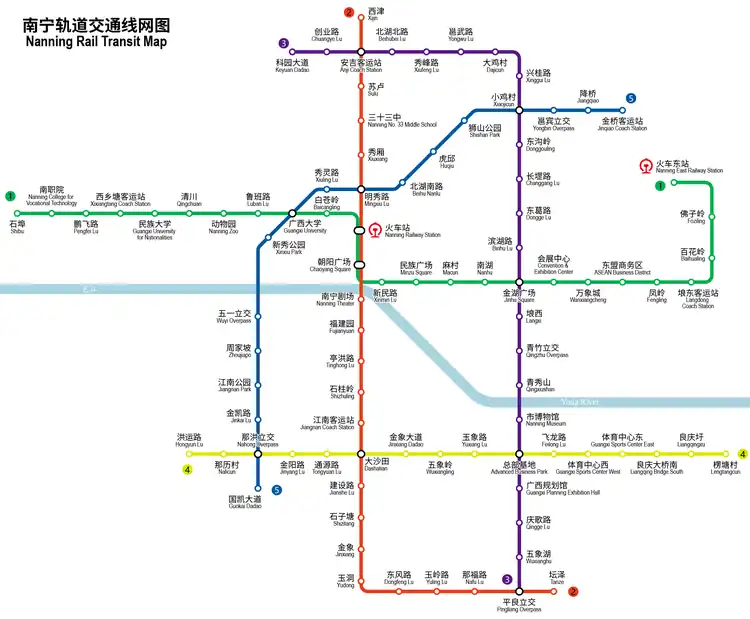Nanning Metro
Nanning Metro or Nanning Rail Transit (NNRT) is a rapid transit system in Nanning, the capital of Guangxi Zhuang Autonomous Region in China.
| Nanning Metro | |||
|---|---|---|---|
| Overview | |||
| Locale | Nanning, Guangxi, China | ||
| Transit type | Rapid Transit | ||
| Number of lines | 5 | ||
| Number of stations | 101 | ||
| Daily ridership | 791,100 (2021 daily avg.)[1] 1.4326 million (31 December 2020 record)[2] | ||
| Annual ridership | 289 million (2021)[1] | ||
| Website | http://www.nngdjt.com/ | ||
| Operation | |||
| Began operation | June 28, 2016 | ||
| Operator(s) | Nanning Rail Transport Limited | ||
| Number of vehicles | 66 (2019) | ||
| Technical | |||
| System length | 128.2 km (79.7 mi) | ||
| Track gauge | 1,435 mm (4 ft 8 1⁄2 in) | ||
| |||
| Nanning Rail Transit | |||||||
|---|---|---|---|---|---|---|---|
| Chinese name | |||||||
| Simplified Chinese | 南宁轨道交通 | ||||||
| Traditional Chinese | 南寧軌道交通 | ||||||
| |||||||
| Alternative Chinese name | |||||||
| Simplified Chinese | 南宁地铁 | ||||||
| Traditional Chinese | 南寧地鐵 | ||||||
| |||||||
| Zhuang name | |||||||
| Zhuang | Nanzningz Didez | ||||||
Lines in operation

| Line | Terminals (District) |
Commencement | Newest Extension |
Length km |
Stations | |
|---|---|---|---|---|---|---|
| 1 | Shibu (Xixiangtang) |
Nanning East railway station (Qingxiu) |
2016 | 2016 | 32.1 | 25 |
| 2 | Xijin (Xixiangtang) |
Tanze (Liangqing) |
2017 | 2020 | 27.3 | 23 |
| 3 | Keyuan Dadao (Xixiangtang) |
Pingliang Overpass (Liangqing) |
2019 | — | 27.9 | 23 |
| 4 | Hongyun Lu | Lengtangcun | 2020 | 20.7 | 16 | |
| 5 | Guokai Dadao | Jinqiao Coach Station | 2021 | 20.2[3] | 17 | |
| Total | 128.2 | 101 | ||||
History
Line 1 officially started construction on December 29, 2011.[4] The first 11.2 km section, from Nanhu to Nanning East railway station, began operation June 28, 2016.[5] The line opened fully on December 28, 2016. It is 32.1 km long, with 25 stations.[4][6] Line 2 started construction in 2012 and was completed on December 28, 2017.[7][8] Line 3 opened in June 2019. Line 4 opened in November 2020. Line 5 opened on December 16, 2021.[3]
With the opening of Line 5, Nanning became the seventh city in China, and the first in Southern China to open and operate a fully automated subway line. [9]
Future Expansion
It is planned that there will be four vertical and four horizontal lines totaling 252 km of subway. The system is projected to carry over 5 million passengers per day.[4][10]
Line 4 will be extended from Lengtangcun to Longgang, adding 3 stations.
Network map
See also
References
- "运送乘客237.1亿人次,新增运营里程1168公里…2021年城市轨道交通运营成绩单". 2022-01-13. Retrieved 19 July 2022.
- "南宁地铁客流量连续两日创新高 1月1日客运量达143.26万人次_南宁新闻网".
- "12月16日!南宁地铁5号线开通时间定了!". Sohu.
- 罗宁 (2011-12-29). "南宁轨道交通一号线工程全线开工". 南宁新闻网 (in Chinese). 人民网. Retrieved 2012-01-01.
- "UrbanRail.Net > Asia > China > Nanning Metro".
- "南宁轨道交通1号线全线开通试运营-广西新闻网". www.gxnews.com.cn. Retrieved 2016-12-28.
- "南宁轨道交通2号线预计年底开工2017年建成 连接玉洞西津". People's Daily. 2013-01-18. Archived from the original on 2013-08-01. Retrieved 2013-08-01.
- chinanews. "南宁地铁2号线开通试运营 轨道交通建成"十字网"-中新网". www.chinanews.com. Retrieved 2017-12-29.
- "南宁地铁5号线开通运营 成为华南地区首条全自动运行地铁线路". 163 News (in Chinese). 2021-12-16.
- "2021年南宁将开通5条地铁线路 轨道交通连线成网". People's Daily. 2017-12-28. Archived from the original on 2017-12-29.